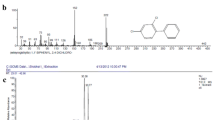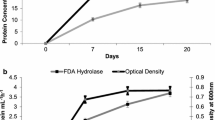Abstract
The catabolic potential of transformer oil contaminated soil bacteria in aerobic degradation of polychlorinated biphenyls (PCB) were assessed. Transformer oil contaminated soil sample was subjected to microcosm enrichment experiments (PAS medium/biphenyl as sole carbon source). PCB-degrading activity of the enrichment cultures in PAS medium with the addition of 2-chlorobiphenyl were analysed by GC–MS indicated that, although the isolates differed in PCB-degrading capabilities, all of the enrichment cultures expressed activity toward at least some of the lower chlorinated congeners. Biphenyl-utilizing bacteria isolated from the most active PCB-degrading mixed cultures showed little taxonomic diversity and identified as Stenotrophomonas maltophilia GS-103.


Similar content being viewed by others
References
Barton MR, Crawford RL (1988) Novel biotransformations of 4-chlorobiphenyl by a Pseudomonas sp. Appl Environ Microbiol 54:594–595
Bedard DL, Wagner RE, Brennan MJ, Haberl ML Jr, Brown JF (1987) Extensive degradation of Aroclors and environmentally transformed polychlorinated biphenyls by Alcaligenes eutrophus H850. Appl Environ Microbiol 53:1094–1102
Borja J, Taleon DM, Auresenia J, Gallardo S (2005) Polychlorinated biphenyls and their biodegradation. Proc Biochem 40:1999–2013
Bradley CA, Kearns RD, Wood PP, Black WE (1996) Degradation of polyhalogenated biphenyl compounds with white-rot fungus grown on sugar beet pulp. US Patent 5583041
Chung SY, Maeda M. Song E, Horikoshi K, Kudo TA (1994) Gram-positive polychlorinated biphenyl-degrading bacterium, Rhodococcus erythropolis strain TA421, isolated from termite ecosystem, Biosci Biotechnol Biochem 58:2111–2113
Egorova DO, Shumkova ES, Demakov VA, Plotnikova EG (2010) Degradation of chlorinated biphenyls and products of their bioconversion by Rhodococcus sp. B7a strain. Appl Biochem Microbiol 46:592–598
Fava F, Zanaroli G, Young LY (2003) Microbial reductive dechlorination of pre-existing PCBs and spiked 2,3,4,5,6-pentachlorobiphenyl in anaerobic slurries of a contaminated sediment of Venice Lagoon (Italy). FEMS Microbiol Ecol 44:309–318
Fedi S, Carnevali M, Fava F, Andracchio A, Zappoli S, Zannoni D (2001) Polychlorinated biphenyl degradation activities and hybridization analyses of fifteen aerobic strains isolated from a PCB-contaminated site. Res Microbiol 152:583–592
Furukawa K, Tomizuka N, Kamibayashi A (1979) Effect of chlorine substitution on the bacterial metabolism of various polychlorinated biphenyls. Appl Environ Microbiol 38:301–310
Gibson DT, Cruden DL, Haddock JD, Zylstra GJ, Brand JM (1993) Oxidation of polychlorinated biphenyls by Pseudomonas sp. strain LB400 and Pseudomonas pseudoalcaligenes KF707. J Bacteriol 175:4561–4564
Hofer B, Backhaus S, Timmis KN (1994) The biphenyl/polychlorinated biphenyl-degradation locus (bph) of Pseudomonas sp. LB400 encodes four additional metabolic enzymes. Gene 144:9–16
Kjellerup BV, Paul P, Ghosh U, May HD, Sowers KR (2012) Spatial distribution of PCB dechlorinating bacteria and activities in contaminated soil. Appl Envt Soil Sci. doi:10.1155/2012/584970
Kohler HP, Kohler-Staub D, Focht D (1988) Cometabolism of polychlorinated biphenyls: enhanced transformation of Aroclor 1254 by growing bacterial cells. Appl Environ Microbiol 54:1940–1945
Komancova M, Jurcova I, Kochankova, Burkhard J (2003) Metabolic pathways of polychlorinated biphenyls degradation by Pseudomonas sp. 2. Chemosphere 50:537–543
Layton AC, Lajoie CA, Easter JP, Jernigan R, Sanseverini J, Sayler GS (1994) Molecular diagnostics and chemical analysis for assessing biodegradation of polychlorinated biphenyls in contaminated soils. J Ind Microbiol 13:392–401
Novakova H, Vosahlikova M, Pazlarova J, Mackova M, Burkhard J, Demnerova K (2002) PCB metabolism by Pseudomonas sp. P2. Int Biodeter Biodegr 50:47–54
Pieper DH (2005) Aerobic degradation of polychlorinated biphenyls. Appl Microbiol Biotechnol 67:170–191
Sakai M, Ezaki S, Suzuki N, Kurane R (2005) Isolation and characterization of a novel polychlorinated biphenyl-degrading bacterium, Paenibacillus sp. KBC101. Appl Microbiol Biotechnol 68:111–116
Seto M, Kimbara K, Shimura M, Hatta T, Fukuda M, Yano K (1995) A novel transformation of polychlorinated biphenyls by Rhodococcus sp. strain RHA1. Appl Environ Microbiol 61:3353–3358
Thompson JD, Gibson TJ, Plewniak F, Jeanmougin F, Higgins DG (1997) The CLUSTAL X windows interface: flexible strategies for multiple sequence alignment aided by quality analysis tools. Nucleic Acids Res 25:4876–4882
Tu C, Teng Y, Luo Y, Li X, Sun X, Li Z, Liu W (2011) Potential for biodegradation of polychlorinated biphenyls (PCBs) by Sinorhizobium meliloti. J Hazardous Mat 186:1438–1444
Wagner-Dobler I, Bennasar A, Vancanneyt M, Strompl C, Brümmer I, Eichner C, Grammel I, Moore ERB (1998) Microcosm enrichment of biphenyl-degrading microbial communities from soils and sediments. Appl Environ Microbiol 64:3014–3022
Williams WA, Lobos JH, Cheetham WE (1997) A phylogenetic analysis of aerobic polychlorinated biphenyl-degrading bacteria. Int J Syst Bacteriol 47:207–210
Xu L, Xu JJ, Jia Y, Liu WB, Jian X (2010) Congener selectivity during polychlorinated biphenyls degradation by Enterobacter sp. LY402. Curr Microbiol. doi:10.1007/s00284-010-9792-1
Acknowledgments
The authors gratefully acknowledge the funding support to carry out this study, as Major Research Project (F. No. 36-150/280(SR)26/3/2009), by University Grants Commission, New Delhi, India.
Author information
Authors and Affiliations
Corresponding author
Rights and permissions
About this article
Cite this article
Somaraja, P.K., Gayathri, D. & Ramaiah, N. Molecular Characterization of 2-Chlorobiphenyl Degrading Stenotrophomonas maltophilia GS-103. Bull Environ Contam Toxicol 91, 148–153 (2013). https://doi.org/10.1007/s00128-013-1044-1
Received:
Accepted:
Published:
Issue Date:
DOI: https://doi.org/10.1007/s00128-013-1044-1




